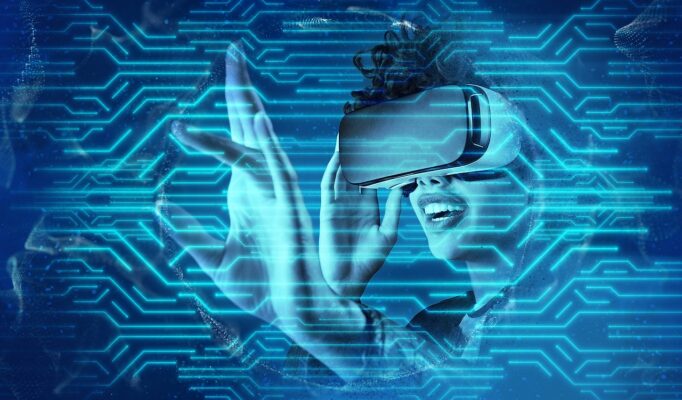AR and VR in Learning: Immersive Learning
In recent years, Augmented Reality (AR) and Virtual Reality (VR) have begun to make significant impacts on various fields, including education. These immersive technologies offer innovative ways to enhance learning experiences, making complex concepts more accessible and engaging. This article explores how AR and VR are transforming education, their benefits, challenges, and future potential.
The Role of AR and VR in Learning
AR and VR create immersive experiences that can transform traditional learning methods. While AR overlays digital information onto the real world, VR creates entirely virtual environments. Both technologies offer unique advantages for educational purposes.
- Augmented Reality (AR): AR enhances the physical learning environment by overlaying digital content, such as images, videos, or 3D models, onto the real world. For example, AR apps can bring historical events or scientific phenomena to life by providing interactive visualizations that students can explore in their own environment.
- Virtual Reality (VR): VR offers fully immersive experiences by creating a simulated environment where learners can interact with 3D objects and scenarios. This technology is particularly useful for subjects that benefit from experiential learning, such as history, science, and engineering.
Benefits of AR and VR in Education
The integration of AR and VR into education provides numerous advantages:
- Enhanced Engagement: AR and VR create interactive and engaging learning experiences that capture students’ attention and foster deeper understanding. The immersive nature of these technologies makes learning more enjoyable and memorable.
- Experiential Learning: Both AR and VR allow students to experience scenarios that would be difficult or impossible to replicate in a traditional classroom. For instance, VR can transport students to ancient civilizations or distant planets, providing firsthand experiences of historical events or scientific phenomena.
- Improved Retention: Immersive learning environments can improve information retention by providing students with experiential learning opportunities. Studies have shown that students who engage in hands-on, interactive experiences often retain information more effectively than those who learn through passive methods.
- Personalized Learning: AR and VR can be tailored to individual learning needs and preferences. For example, VR simulations can adapt to a student’s skill level, allowing for personalized pacing and instruction.
- Safe Learning Environments: VR enables students to practice skills and explore scenarios in a risk-free environment. This is particularly valuable for training in fields such as medicine, aviation, and engineering, where real-world practice can be costly or dangerous.
Challenges of AR and VR in Education
Despite their potential, AR and VR in education face several challenges:
- Cost and Accessibility: The initial setup costs for AR and VR technologies can be high, and not all educational institutions have the resources to invest in these tools. Ensuring widespread access to AR and VR technology remains a significant challenge.
- Technical Limitations: The effectiveness of AR and VR experiences depends on the quality of the technology and content. Technical issues such as lag, low resolution, or lack of content can hinder the learning experience.
- Content Development: Creating high-quality AR and VR educational content requires specialized skills and resources. Developing engaging and effective content can be time-consuming and expensive.
- Training and Support: Educators need training and support to effectively integrate AR and VR into their teaching practices. Professional development programs are essential to help teachers harness the full potential of these technologies.
- Health and Safety: Prolonged use of VR headsets can cause discomfort or health issues for some users. It is important to monitor usage and ensure that students take regular breaks to avoid potential negative effects.
The Future of AR and VR in Education
The future of AR and VR in education is promising, with ongoing advancements expected to further enhance their impact:
- Increased Accessibility: As technology becomes more affordable and widely available, AR and VR are likely to become more integrated into mainstream education. Efforts to reduce costs and improve accessibility will play a crucial role in this process.
- Advanced Content Creation: Future developments in AR and VR content creation tools will make it easier for educators to develop high-quality, interactive learning experiences. Enhanced software and user-friendly platforms will streamline content development.
- Collaborative Learning: AR and VR have the potential to facilitate collaborative learning experiences, allowing students to work together in virtual environments. This can enhance teamwork and communication skills.
- Integration with Other Technologies: The integration of AR and VR with other technologies, such as Artificial Intelligence (AI) and the Internet of Things (IoT), could further enhance educational experiences. For example, AI could provide personalized feedback within VR simulations, and IoT devices could create interactive, real-time learning environments.
- Global Learning Opportunities: AR and VR can offer global learning experiences by connecting students from different parts of the world in virtual spaces. This can foster cross-cultural understanding and collaboration.
Conclusion
AR and VR are revolutionizing education by offering immersive, interactive learning experiences that engage students and enhance their understanding. While challenges remain, ongoing advancements and increased accessibility promise a bright future for these technologies in education. As AR and VR continue to evolve, their potential to transform learning and teaching will undoubtedly expand, making education more dynamic, inclusive, and effective.





